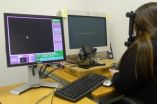(Press-News.org) MANHATTAN, Kan. -- The more you sit, the higher your risk of chronic diseases.
Kansas State University researcher Richard Rosenkranz, assistant professor of human nutrition, examined the associations of sitting time and chronic diseases in middle-aged Australian males in a study that is published in the International Journal of Behavioral Nutrition and Physical Activity. Collaborators include University of Western Sydney researchers Emma George and Gregory Kolt.
The study's sample included 63,048 males ages 45-65 from the Australian state of New South Wales. Study participants reported the presence or absence of various chronic diseases, along with their daily sitting time: categorized as less than four hours, four to six hours, six to eight hours, or more than eight hours.
Compared with those who reported sitting four hours or less per day, those who sat for more than four hours per day were significantly more likely to report having a chronic disease such as cancer, diabetes, heart disease and high blood pressure. The reporting of chronic diseases rose as participants indicated they sat more. Those sitting for at least six hours were significantly more likely to report having diabetes.
"We saw a steady stair-step increase in risk of chronic diseases the more participants sat," Rosenkranz said. "The group sitting more than eight hours clearly had the highest risk."
The study is relevant to office workers sitting at desks and those sitting for long periods of time such as truck drivers, he said.
"We know that with very high confidence that more physically active people do better with regard to chronic disease compared with less physically active people, but we should also be looking at reducing sitting," Rosenkranz said. "A lot of office jobs that require long periods of sitting may be hazardous to your health because of inactivity and the low levels of energy expenditure."
Researchers discovered consistent findings in those who had a similar physical activity level, age, income, education, weight and height. Participants who sat more reported more chronic diseases -- even if they had a similar body mass index compared with those who sat less.
In general, people should get more physical activity and sit less, Rosenkranz said.
"It's not just that people aren't getting enough physical activity, but it's that they're also sitting too much," he said. "And on top of that, the more you sit, the less time you have for physical activity."
The study focused on males, because they have higher rates of diabetes and heart disease, but it is probably applicable in adults across gender, race and ethnicity, Rosenkranz said. Little is known about children and sitting with regard to chronic disease.
The research is part of the 45 and Up Study, the largest long-term study of aging in Australia, involving more than 267,000 people.
Researchers said that although most of the current evidence is suggestive of a causal connection, they cannot be certain in this study whether volumes of sitting time led to the development of chronic diseases or whether the chronic diseases influenced sitting time.
"It's a classic case of, 'Which came first: The chicken or the egg?'" Rosenkranz said.
### END
Sitting time associated with increased risk of chronic diseases
2013-02-19
ELSE PRESS RELEASES FROM THIS DATE:
'Simplified' brain lets the iCub robot learn language
2013-02-19
VIDEO:
In a video demonstration, a researcher asks the iCub robot to point to a guitar (shown in the form of blue object) then asking it to move a violin to...
Click here for more information.
This technological prowess was made possible by the development of a "simplified artificial brain" that reproduces certain types of so-called "recurrent" connections observed in the human brain.
The artificial brain system enables the robot to learn, and subsequently understand, new sentences ...
History of stroke and coronary heart disease -- a fatal combination
2013-02-19
Heart and cerebro-vascular disorders represent the two leading causes of death throughout the world. They are sometimes combined in a single patient and their combination represents both a considerable risk to the patient and a therapeutic challenge.
Today's anti-thromobotic, blood-thinning medication provides effective treatment for coronary heart disease. Several randomised tests to assess new anti-thrombotic treatments in coronary patients have identified the fact that a history of stroke or TIA constitutes a marker for increased risk of intracranial bleeding that ...
Atherosclerosis -- Monocyte migrations
2013-02-19
Atherosclerosis is one of the commonest causes of death in modern societies. The condition is characterized by the build-up of fatty deposits called atherosclerotic plaques on the inner surfaces of arteries, which restrict, and may eventually cut off, blood flow. The deposits can also be dislodged from their site of origin and may then block major vessels in the heart or the brain, leading to life-threatening myocardial infarction or stroke.
Monocytes, an important class of white blood cells, are known to contribute significantly to the development of atherosclerosis. ...
Eye movements reveal reading impairments in schizophrenia
2013-02-19
A study of eye movements in schizophrenia patients provides new evidence of impaired reading fluency in individuals with the mental illness.
The findings, by researchers at McGill University in Montreal, could open avenues to earlier detection and intervention for people with the illness.
While schizophrenia patients are known to have abnormalities in language and in eye movements, until recently reading ability was believed to be unaffected. That is because most previous studies examined reading in schizophrenia using single-word reading
tests, the McGill researchers ...
'Quality of life' therapy improves health during cancer treatment, Mayo Clinic finds
2013-02-19
ROCHESTER, Minn. -- Therapy to ease stress, fatigue and other quality of life issues significantly improves patients' sense of well-being during cancer treatment, new Mayo Clinic research shows. Patients who kept to their standard routines showed a decline in quality-of-life measures, the study found. The findings are published this month in Cancer.
Mayo cancer care specialists created a six-session program to address cognitive, physical, emotional, social and spiritual well-being. Each session includes physical therapy exercises to improve fatigue, discussions of topics ...
Raw meat diet may not be enough for cats (or tigers)
2013-02-19
Animal scientists say a raw meat diet is a good source of protein for cats, but pet owners may need to supplement with other nutrients.
In a new paper in the Journal of Animal Science, researchers from the University of Illinois at Urbana-Champaign and Omaha's Henry Doorly Zoo and Aquarium analyzed the value of raw meat diets for cats and exotic felids. The researchers used several tests to evaluate the nutrients in meat from bison, cattle, horses and elk.
To test how the different diets affected cats, the researchers collected blood serum and fecal samples from domestic ...
When it comes to genetic code, researchers prove optimum isn't always best
2013-02-19
COLLEGE STATION, Feb. 18, 2013 — Imagine two steel springs identical in look and composition but that perform differently because each was tempered at a different rate.
A team of researchers including a Texas A&M University molecular biologist has shown that concept — that the speed of creation affects performance — applies to how a protein they studied impacts an organism's circadian clock function. This discovery provides new insights into the significance of the genetic code for controlling the rates at which critically important proteins are synthesized, and could ...
Study: p38beta MAPK not critical to brain inflammation
2013-02-19
LEXINGTON, Ky. (Feb. 18, 2013) — A study by a leading Alzheimer's researcher at the University of Kentucky provides new evidence that will help researchers home in on the molecular mechanisms involved in inflammation of the central nervous system (CNS) and aid drug-development strategies for treating inflammatory neurological diseases.
The research was led by Linda Van Eldik, director of UK's Sanders-Brown Center on Aging, and included co-authors Bin Xing and Adam Bachstetter from the Van Eldik lab. The study demonstrated that the beta isoform of p38 mitogen-activated ...
Variations within influenza strain may explain varying patient response
2013-02-19
LOUISVILLE, Ky. – Just the mention of H1N1 can conjure up images of long lines of people waiting to be vaccinated, news reports of the severity of the pandemic and the count of the number of people who perished from the 2009-10 outbreak. However, some positives are coming forward.
Researchers at the University of Louisville have found variations within H1N1 patients who were hospitalized and identified those that most impacted patients. Their findings were published today (Feb. 18, 2013) on the PLOS ONE website.
"While all of the variants that we uncovered hijacked ...
Johns Hopkins Medicine and Fundación Santa Fe de Bogotá collaboration to focus on research, nursing
2013-02-19
An expansion of collaborative projects involving Fundación Santa Fe de Bogotá (FSFB), one of Colombia's premier health care institutions, and Johns Hopkins Medicine International (JHI) will continue for another 10 years under an agreement signed Feb. 18, 2013, in Baltimore, USA. The collaboration agreement detailing joint efforts in research and nursing, among other areas, was signed by Steven J. Thompson, chief executive officer of JHI, and Juan Pablo Uribe, chief executive officer of FSFB.
"It is a privilege to have the opportunity to strengthen our collaboration with ...

